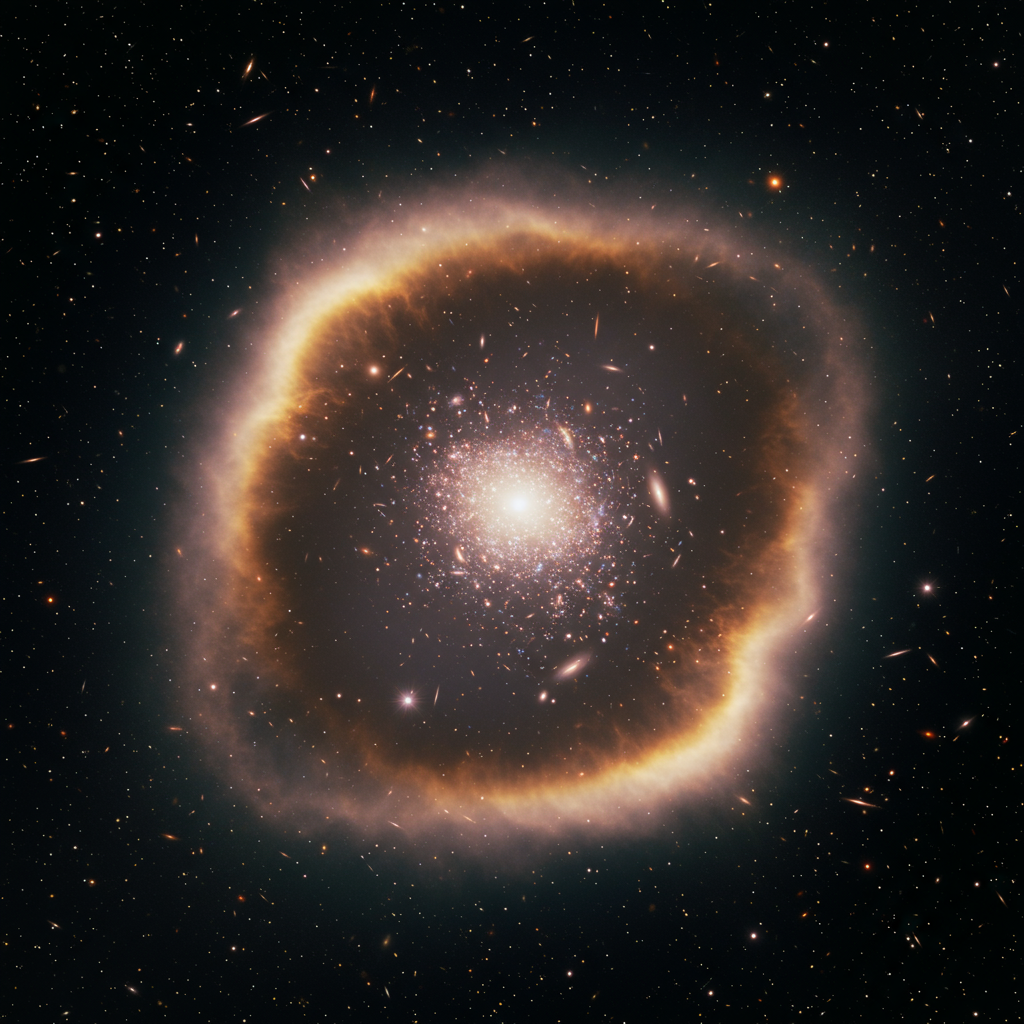Astronomers have made a landmark discovery, uncovering a vast cloud of high-energy particles surrounding one of the most distant galaxy clusters ever seen. This celestial phenomenon, dubbed a “radio mini-halo,” is located a staggering 10 billion light-years away. Its detection offers unparalleled insights into how the largest structures in the universe were formed and energized in the cosmic dawn. This finding marks a significant step forward in understanding the hidden forces that have shaped the cosmos over billions of years.
What Exactly is a Radio Mini-Halo?
Radio mini-halos are diffuse patches of radio emission found around the bright central galaxies within massive galaxy clusters. Imagine them as gigantic clouds of energetic particles suspended in the space between galaxies in a cluster. These particles, primarily electrons, spiral within the cluster’s magnetic fields at near-light speeds. This spiraling motion causes them to emit radio waves, which telescopes on Earth can detect.
Finding these mini-halos in nearby galaxy clusters is relatively common. They reveal the presence of high-energy particles pervading the thin, hot gas that fills these cosmic structures. However, detecting one at an extreme distance – meaning we see it as it was billions of years ago – was a significant surprise. It indicates that the conditions necessary to create and sustain these energetic particle clouds were already in place much earlier in cosmic history than previously thought.
The Discovery: A Cosmic Beacon from 10 Billion Years Ago
The groundbreaking discovery was made by an international team of researchers analyzing data from the Low Frequency Array (LOFAR) radio telescope. LOFAR is a vast network, linking over 100,000 small antennas spread across eight European countries. Its exceptional sensitivity is crucial for detecting faint cosmic signals.
The team focused their observations on a distant galaxy cluster known as SpARCS1049. Light from this cluster has traveled for 10 billion years to reach us. This means we are observing SpARCS1049 as it appeared when the universe was only about 3.8 billion years old. While studying this ancient cluster, astronomers detected a faint, widespread radio signal. Crucially, this glow didn’t come from individual galaxies. Instead, it emanated from a vast region of space between them.
Stretching over a million light-years, this diffuse glow was recognized as a radio mini-halo. This makes it the most distant mini-halo ever detected. Its distance is double that of the previous record holder. Co-led by Julie Hlavacek-Larrondo of Université de Montréal and Roland Timmerman of Durham University, the research team published their findings in The Astrophysical Journal Letters. The sheer strength of the signal detected at such a distance was particularly astonishing to the scientists.
Why This Ancient Mini-Halo Matters for Cosmic Evolution
The detection of a mini-halo in a cluster so far away provides a unique window into the early universe. It shows that energetic particles and magnetic fields were already shaping galaxy clusters billions of years ago. Galaxy clusters are among the largest known structures in the cosmos. This discovery suggests they have been immersed in high-energy environments for most of their existence.
“It’s as if we’ve discovered a vast cosmic ocean, where entire galaxy clusters are constantly immersed in high-energy particles,” said Hlavacek-Larrondo.
The presence of this mini-halo 10 billion years in the past pushes back the timeline for when these energetic processes became significant in the universe. It allows astronomers to study the physical conditions of young galaxy clusters directly. Understanding where these high-energy particles come from and how they are sustained over cosmic timescales is crucial. It helps piece together the complex history of how large cosmic structures grow and evolve. This finding strongly implies that energetic processes were critical drivers of evolution even when the universe was just a fraction of its current age.
Unpacking the Energy: Two Leading Explanations
Scientists propose two main scenarios to explain the origin and maintenance of the high-energy particles that form mini-halos. Both involve powerful cosmic phenomena.
Supermassive Black Holes as Particle Launchers
One possibility is that supermassive black holes residing at the centers of galaxies within the cluster are the source. Black holes are incredibly dense objects with gravity so intense nothing, not even light, can escape their event horizon. Supermassive black holes, millions or billions of times the sun’s mass, are thought to anchor nearly every galaxy, including our own Milky Way. While challenging to detect directly as they emit no light, their presence is revealed by their effects on surrounding matter.
When gas and dust spiral into a black hole (a process called accretion), powerful jets of high-energy particles and plasma can be ejected at near-relativistic speeds. If the central galaxy in SpARCS1049 had a particularly active supermassive black hole, these jets could have injected vast amounts of energetic particles into the surrounding cluster gas. However, a key challenge with this explanation is understanding how these particles could travel millions of light-years away from the black hole and still retain enough energy to power such a vast radio glow. Their energy should dissipate over such large distances.
Cosmic Particle Collisions
The second likely explanation involves high-energy particle collisions within the hot plasma that permeates galaxy clusters. This plasma consists of charged particles moving throughout the cluster’s gravitational potential. According to this theory, charged particles already present in this plasma collide at near-light speeds. These high-energy collisions can fragment particles. This process creates a population of highly energetic electrons. These electrons then interact with the cluster’s magnetic fields, emitting the radio waves detected as a mini-halo.
This mechanism offers a potential explanation for the diffuse, widespread nature of the mini-halo. Unlike energy injected from a single point source like a black hole jet, collisions can occur throughout regions of dense plasma. This process could provide a continuous source of energetic particles wherever the gas is sufficiently dense. Distinguishing between these two models (black hole feedback vs. collision re-acceleration) is a major goal for astronomers. It impacts our understanding of how energy is distributed within galaxy clusters over cosmic time.
Peering Further into the Cosmic Past
Detecting this faint, diffuse radio signal required the exceptional sensitivity of the LOFAR array. Its ability to observe at low radio frequencies was also critical. These wavelengths are less affected by absorption and scattering from foreground gas and dust. This allows astronomers to probe deeper into the universe.
The success of this discovery highlights the potential of next-generation instruments. Telescopes currently under development, such as the Square Kilometre Array (SKA), promise even greater sensitivity and resolution. SKA is expected to become the world’s largest radio observatory. It will be capable of detecting even fainter radio signals from the early universe.
With SKA and other future observatories, scientists will be able to map distant mini-halos with higher precision. They can measure their magnetic fields more accurately. Future observations might even reveal if these mini-halos flicker. Such flickering could indicate episodic energy injection events, potentially tied to periods of black hole activity. These advancements will further explore the roles of magnetic fields, cosmic rays, and energetic processes in shaping the largest structures in the universe.
Connecting the Dots: Cosmic Distances and the Universe’s Age
Measuring the distance to objects like SpARCS1049 is fundamental to understanding the cosmos. Astronomers like Edwin Hubble first showed that the universe is expanding. Telescopes like the Hubble Space Telescope refined these distance measurements dramatically. They use cosmic “standard candles” like Type Ia supernovae and Cepheid variable stars. By measuring the apparent brightness of these objects and knowing their true intrinsic luminosity, scientists can calculate their distance. Combining distance data with the speed at which galaxies are moving away from us allows astronomers to determine the universe’s expansion rate, the Hubble Constant. Current precise measurements place the age of the universe at about 13.8 billion years.
Surprisingly, Hubble observations also revealed that the universe’s expansion is accelerating. This phenomenon is attributed to a mysterious force called dark energy. While its nature remains unknown, dark energy seems to act as a repulsive force, pushing space apart. The confirmation of these measurements by the James Webb Space Telescope reinforces this cosmic puzzle. Discoveries like the distant mini-halo in SpARCS1049 fit into this larger picture. They provide crucial data points about the universe’s state billions of years ago. Such data helps scientists piece together the timeline of cosmic events. It sheds light on when certain physical processes became dominant in driving structure formation and evolution.
Frequently Asked Questions
What is a radio mini-halo and why is finding a distant one significant?
A radio mini-halo is a vast cloud of high-energy particles that emits radio waves, found in the space between galaxies within a galaxy cluster. Discovering the most distant mini-halo ever detected, 10 billion light-years away in the cluster SpARCS1049, is highly significant. It means we are seeing this structure as it was in the early universe, just 3.8 billion years after the Big Bang. This shows that galaxy clusters were infused with energetic particles much earlier than previously known, providing a rare look at the physical conditions of these massive structures in their youth.
How did astronomers detect this ancient mini-halo?
Astronomers used data from the Low Frequency Array (LOFAR) radio telescope. This vast network of antennas across Europe is extremely sensitive. By analyzing observations of the distant galaxy cluster SpARCS1049, researchers detected a faint, diffuse radio signal. Unlike typical radio sources that come from individual galaxies, this signal was spread over a million light-years, characteristic of a mini-halo. LOFAR’s unique capabilities allowed them to differentiate this subtle glow from other cosmic radio sources.
What are the possible sources of energy for this distant mini-halo?
Scientists propose two main explanations for the high-energy particles powering the mini-halo in SpARCS1049. One possibility is jets of energetic particles ejected by active supermassive black holes at the centers of galaxies within the cluster. The second possibility is high-speed collisions between charged particles already present in the hot gas that fills the galaxy cluster. Both mechanisms could create the ultra-relativistic electrons needed to produce the observed radio emission when interacting with magnetic fields, but scientists are still working to determine which process is dominant in the early universe.
Conclusion
The discovery of the most distant radio mini-halo provides compelling evidence that the early universe was a more energetic place than previously understood. This diffuse glow from 10 billion years ago reveals that vast galaxy clusters were already shaped by high-energy particles and magnetic fields when the cosmos was in its relative youth. While the exact source of this energy – potentially supermassive black holes or cosmic particle collisions – remains a subject of ongoing research, this finding offers an invaluable window into the physical processes that drove the evolution of the universe’s largest structures. As new, more powerful telescopes come online, astronomers are poised to detect even fainter signals. This will allow them to unravel more secrets about the energetic cosmic environment that sculpted the universe we see today. We are truly just beginning to understand how dynamic the early cosmos really was.
Word Count Check: ~1120 words




